Abstract
The ecological environment of Inner Mongolia constitutes a critical component of China’s ecological civilization construction. To comprehensively assess and monitor ecological quality dynamics in this region, this study employed MODIS remote sensing data products (2000–2020) and derived four key indicators, —vegetation index (NDVI), wetness index (WET), build-up and soil index (NDBSI), and land surface temperature (LST)—via the Google Earth Engine (GEE) platform. A Remote Sensing-based Ecological Index (RSEI) was constructed using principal component analysis (PCA) to establish an annual long-term time series, thereby eliminating subjective bias from artificial weight assignment. Integrated methodologies—including Theil–Sen Median and Mann–Kendall trend analysis, Hurst exponent, and geographical detector—were applied to investigate the spatiotemporal evolution of ecological quality in Inner Mongolia and its responses to climatic and anthropogenic drivers. This study proposes a novel framework for large-scale ecological quality assessment using remote sensing. Key findings include the following: The mean RSEI value of 0.41 (2000–2020) indicates an overall improving trend in ecological quality. Areas with ecological improvement and degradation accounted for 76.06% and 23.84% of the region, respectively, exhibiting a spatial pattern of “northwestern improvement versus southeastern degradation.” Pronounced regional disparities were observed: optimal ecological conditions prevailed in the Greater Khingan Range (northeast), while the Alxa League (southwest) exhibited the poorest conditions. Northwestern improvement was primarily driven by increased precipitation, rising temperatures, and conservation policies, whereas southeastern degradation correlated with rapid urbanization and intensified socioeconomic activities. Our results demonstrate that MODIS-derived RSEI effectively enables large-scale ecological monitoring, providing a scientific basis for regional green development strategies.
1. Introduction
The quantitative assessment of ecological environment quality is a complex and challenging task. Remote sensing technology has been widely applied in habitat quality research due to its enhanced efficiency and accuracy [1,2,3,4].
Currently, ecological environment assessment methods are primarily classified into two categories [5,6]: single remote sensing ecological indices such as Enhanced Vegetation Index (EVI) [4], normalized difference vegetation index (NDVI) [7], Net Primary Production (NPP) [8,9,10], drought assessment through standardized precipitation evapotranspiration index [11,12,13], urban heat island effect studies through land surface temperature index [14,15], and so forth; as well as comprehensive models like the DPSIR model [1,16] and the Analytic Hierarchy Process (AHP) [12]. However, utilizing a single index cannot comprehensively and accurately assess habitat quality and comes with limitations and randomness [4,7,8]; comprehensive models typically require on-site data collection; weight assignments based on expert opinions; and are time-consuming, highly subjective, and more suitable for small geographic units [4].
Hanqiu Xu [2] proposed a Remote Sensing Ecological Index that integrates four indicators: greenness, wetness, dryness, and warmth. Each indicator is determined according to its inherent nature, and the index employs the PCA (principal component analysis) method for non-artificial weighting determination. Thus, this index enables rapid evaluation and monitoring of ecological quality, facilitates modeling of regional ecological environmental changes, spatial–temporal analysis, and visualization. Compared to single-index analysis, it provides a more comprehensive, accurate, and objective representation of ecological quality status. This proposal has gained wide recognition [12] and has been applied in ecological environment quality assessments at different spatial scales such as urban areas, watersheds, and regions [17,18,19,20].
MODIS data offer good spatial resolution, complete time series, and extensive spatial coverage. Utilizing MODIS data to construct remote sensing ecological indices is of significant importance for achieving comprehensive ecological quality remote sensing assessments over large areas [1,2,4].
In this study, based on the Google Earth Engine (GEE) platform, using the Moderate-Resolution Imaging Spectroradiometer (MODIS) data products MOD09A1, MOD11A2, and MOD13A1, after pre-processing the raw data, greenness (NDVI), wetness (WETNESS), temperature (land surface temperature, LST), and dryness (DRYNESS) were calculated to construct the Remote Sensing-based Ecological Index (RSEI) [1]. The analysis aimed at understanding the spatiotemporal evolution patterns of ecological environment quality in the Inner Mongolia Autonomous Region from 2000 to 2020 and its response to climate and human activities.
2. Materials and Methods
2.1. Overview of Study Area and Data Acquisition
The Inner Mongolia Autonomous Region is located in northern China and extends in a narrow shape from the northeast to the southwest. It starts at 126°04′ East longitude and extends to 97°12′ East longitude, spanning over 28°52′ in longitude, with a straight-line distance of more than 2400 km from east to west (Figure 1). It ranges from 37°24′ North latitude in the south to 53°23′ North latitude in the north, covering a vertical distance of 15°59′ with a straight-line distance of 1700 km. The total area of the region is 1.183 million square kilometers, accounting for 12.3% of China’s land area, making it the third largest province-level division in China.
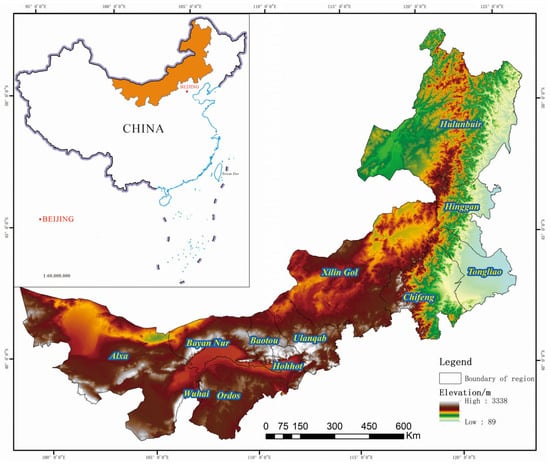
Figure 1.
The geographical location and elevation of Inner Mongolia.
The terrain of Inner Mongolia is characterized by a high southern region and a low northern region, with an average elevation of about 1000 m. The types of vegetation cover range from forest steppe, steppe, desert steppe, to desert from east to west. The land forms predominantly include mountains, plateaus, and deserts, classifying it as a temperate desert steppe region. Annual precipitation is scarce, and evaporation is strong. The growing season mainly occurs from April to September, with average temperatures ranging between 3.87 °C and 25.02 °C, increasing from southwest to northeast. The annual precipitation is 299.64 mm, gradually increasing from west to east, accounting for 89.47% of the total annual precipitation. The annual evaporation ranges from 1000 mm to 3000 mm, showing an increasing trend from east to west, while the annual sunshine hours decrease from west to east.
Due to meteorological factors such as precipitation and temperature, the western area mainly consists of wasteland and desert, while the central region is predominantly a grassland ecosystem, covering approximately 8.8 million square kilometers, which represents 22% of the total grassland area in the country. The eastern region is primarily composed of boreal coniferous forests. The multi-year average rainfall is 253.45 mm, with precipitation concentrated mainly in July, August, and September. The multi-year average temperature ranges from 1.5 °C to 3.7 °C, with annual sunshine hours ranging from 3100 to 3300 h. The multi-year average evaporation is 2480.57 mm. Inner Mongolia is a principal component of the northern sand prevention zone and is recognized as a typical ecologically fragile area in China, serving as an important ecological barrier in the north, and is classified as a key ecological function area by the state.
2.2. Data Sources and Processing
Remote Sensing Data: The remote sensing data used in this study comes from the Moderate-Resolution Imaging Spectroradiometer (MODIS) data products MOD09A1, MOD11A2, and MOD13A1. The temporal resolution of these data is 16 days, and the spatial resolution is 500 m. The DEM data (downloadable from https://www.gscloud.cn/) has a spatial resolution of 30 m. This study utilized 2880 MODIS scenes (MOD09A1, MOD11A2, and MOD13A1 products) from June to September during 2000–2020 for six tile regions (h25v03-h26v05) to cover the vegetation growing seasons.
Meteorological Data: This includes air temperature and precipitation data, both with a spatial resolution of 500 m. Annual precipitation data was obtained from the National Earth System Science Data Center (downloadable from https://www.geodata.cn/) with a spatial resolution of 1 km. The time span for all the above data is from 2000 to 2020.
Socioeconomic Data: This includes gross domestic product (GDP), population density, and night light intensity, with data sourced from the Resource and Environmental Science Data Platform (https://www.resdc.cn/). The spatial resolution of these data was resampled to 1 km × 1 km.
A detailed workflow was established for this study (Figure 2). By writing code on Google Earth Engine (GEE: https://earthengine.google.com/), average values of the MOD09A1, MOD11A2, and MOD13A1 products for the months of July to September from 2000 to 2020 were calculated as the data foundation for constructing a comprehensive Remote Sensing Ecological Index. Pre-processing of remote sensing data was carried out, including removing clouds, projection transformation, applying water mask, and resampling, to eliminate indicator deviations and obtain uniform raster data for various indicators. This resulted in long-term time series datasets for NDVI, LST, WET, and NDBSI. To avoid significant disparities in indicator weights, the four indicators were normalized, and PCA transformation was conducted on the four variables to obtain the first principal component analysis result (PCA1). The thematic map production and graphical analysis were performed using ArcGIS 10.2, Origin 2024, and MATLAB 2020 software.
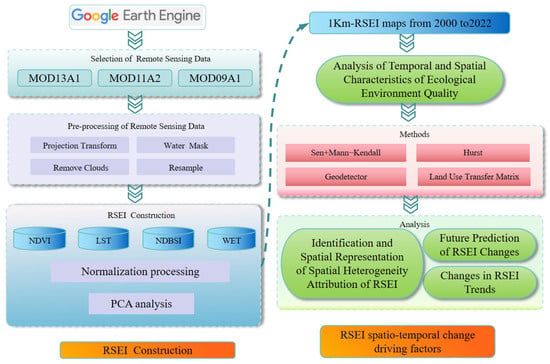
Figure 2.
Workflow image.
3. Methods
3.1. Remote Sensing Ecological Index (RSEI) Model Construction
- (1)
- Greenness Calculation
The calculation of greenness typically considers vegetation indices. Studies have shown that the normalized difference vegetation index (NDVI) is closely related to vegetation biomass, leaf area index, and vegetation coverage, and can, to some extent, represent the ecological environment. The formula for calculating the NDVI is:
where NIR represents the reflectance in the near-infrared band and Red represents the reflectance in the red band. NDVI values generally range from −1 to 1, with higher values indicating denser vegetation coverage.
- (2)
- Humidity
This study uses the wetness component in the tasseled cap transformation to calculate humidity. There are significant differences in tasseled cap transformation parameters between different sensors. To eliminate the discrepancies in results caused by different tasseled cap parameters during the temporal calculation process, this paper selects the wetness parameters from reference [18] as the model for humidity calculation, thereby retaining the original meaning of the indicators and ensuring continuity between sensors. The calculation formula is as follows:
In the formula, WET represents dryness, and Ri(i = 1, 2, 3, …, 7) represents the reflectance of each band from the MOD09A1 surface reflectance product.
- (3)
- Dryness
Xu Hanqiu [1] calculates the dryness index (normalized difference building and soil index, NDBSI) using the Built-up Index (Index-Based Built-Up Index, IBI) and the Bare Soil Index (Bare Soil Index, BSI). The calculation formula for dryness is as follows:
In the formula, NDBSI represents dryness, γ is a parameter coefficient, typically ranging from 0 to 1.0. Here, based on previous experience, we set γ = 0.5. Ri(i = 1, 2, 3, …, 7) represents the reflectance of each band from the MOD09A1 surface reflectance product.
- (4)
- Temperature Calculation
In this study, the GEE platform is used to convert daytime land surface temperature data into actual land surface temperature. The gray values of the MOD11A2 remote sensing data are converted into commonly used degrees Celsius to represent land surface temperature (LST) [16]. The specific formula is as follows:
In the formula, LST represents temperature, and dryness (DN) represents the grayscale value of land surface temperature.
- (5)
- RSEI Model Construction
To fully utilize the characteristics of the four ecological variables for constructing the Remote Sensing Ecological Index (RSEI), this paper employs principal component analysis (PCA) to synthesize the four variables. PCA is a multidimensional data compression technique that selects a few important variables through orthogonal linear transformations of multiple variables. Its main advantage is that the weights of the indicators are not determined artificially but are automatically and objectively determined based on the properties of the data itself, according to the contribution of each indicator to the principal components. This approach helps to avoid result deviations that may arise from subjective weighting [3]. Finally, by applying PCA to the four variables, the first principal component result (PCA1) is obtained, resulting in the RSEI, which has a value range of [0, 1]. A value closer to 1 indicates higher ecological environment quality, while a value closer to 0 indicates lower ecological environment quality. The calculation formula is as follows:
3.2. Sen + Mann–Kendall Trend Analysis Method
The Theil–Sen Median slope estimation method, also known as the Sen slope estimation, is a robust non-parametric statistical method for trend calculation. It does not rely on distributional assumptions about the data, effectively avoiding the impact of missing data and data distribution on the results during computation. It has strong resistance to data errors and is suitable for various types of data, making the analysis results more scientific and trustworthy [20,21,22]. Therefore, this paper uses the Theil-Sen Median slope estimation to analyze the temporal changes in RSEI in Inner Mongolia from 2000 to 2020. The calculation formula is as follows:
In the equation: RSEIi and RSEIj represent the RSEI values in years i and j (2000 ≤ I < j ≤ 2020); Sen being positive indicates an increasing trend in the RSEI, while negative signifies a decreasing trend. The larger the absolute value of Sen, the greater the magnitude of RSEI change; the closer the absolute value of Sen is to 0, the smaller the magnitude of RSEI change.
The Mann–Kendall (MK) test is a non-parametric method for testing time series trends. It does not require the data to follow a normal distribution and is not affected by missing or outlier values, making it suitable for trend significance testing in long time series data. Therefore, this study employs the Mann–Kendall test to analyze the significance of temporal changes in ecological environment quality in Inner Mongolia from 2000 to 2020. The calculation formula is as follows:
In the equation: S is the test statistic for the Mann–Kendall test; xj and xk are the corresponding measurement values; n is the length of the time series; Sgn is the sign function. The significance level thresholds are ±1.96 and ±2.58, corresponding to 95% significance testing and 99% significance testing, respectively. When the value of ZMK falls within the range of 1.96 to 2.58, it indicates that the increasing trend is significant at the 95% level; if ZMK ≥ 2.58, it indicates that the increasing trend is significant at the 99% level, and vice versa.
The results of the Mann–Kendall test and Theil–Sen slope estimation can determine the significance of the RSEI change trend, as specifically shown in Table 1.

Table 1.
RSEI trend grading reference table.
3.3. Future Trend Analysis (Hurst Exponent)
The Hurst exponent is an effective method for describing self-similarity and long-term dependence, without the need for the usual assumption of independent random events in probability statistics. This study utilizes the Hurst exponent to predict the future trend of RSEI data. Currently, there are various estimation methods for the Hurst exponent, such as the absolute value method, aggregate variance method, periodogram method, wavelet analysis method, residual analysis method, and R/S analysis method [23,24]. Research indicates that the Hurst exponent estimated by the R/S analysis method is more reliable compared to results obtained by other methods [23]. The R/S analysis approach was utilized in this study (Table 2). The formula is as follows:

Table 2.
Reference table for sustainability grading of RSEI changes.
3.4. Geodetector
The geographical detector is a method that identifies driving forces by analyzing the spatial stratified heterogeneity of dependent variables. In this study, we employed three modules of the geographical detector—factor detector, interaction detector, and ecological detector—to conduct driving force analysis and quantitative attribution of ecological environment quality in the study area [24,25,26].
The factor detector examines both the spatial differentiation of dependent variables and the explanatory power of independent variables [27,28]. Specifically, the explanatory power (q value) of influencing factor x on the spatial differentiation characteristics of RSEI can be expressed as:
L represents the number of strata for independent variable x; Nh and N denote the number of samples within each stratum and the entire region, respectively; σ2 is the overall variance of samples (the model holds when σ2 ≠ 0); SST is the within-stratum variance sum; SST is the total sample variance. The q value ranges between [0,1]. A higher q indicates stronger explanatory power of x over RSEl’s spatial differentiation. In extreme cases: q = 1 implies the factor completely controls the spatial distribution of the target variable; q = 0 suggests no relationship between the factor and the target variable. The q value quantifies that X explains 100x q% of Y [24,29].
3.5. Land Use Transfer Matrix
The land use transfer matrix is an application of the Markov model in land use change, reflecting the dynamic process of mutual transformation of land area categories at the beginning and end of a certain period in a specific region. It not only includes static data on land area for various categories at a specific point in time within a defined area, but also contains richer information regarding the outflows of land area categories at the beginning and the inflows of land area categories at the end of the period. This study utilizes the land use transfer matrix to visually reflect the migration pathways of ecological environment quality in Inner Mongolia. The general form of the land use transfer matrix is as follows:
where Sij represents the area that transitions from land use type i to land use type j over a specific period, and n is the number of land use types.
4. Results and Discussion
4.1. RSEI Quality Assessment in the Study Area
4.1.1. Results of Principal Component Analysis
To validate the PCA outcomes, this study conducted a sampling analysis for the years 2010 and 2020. As illustrated in Figure 3, the first principal component (PC1) accounted for 83.04% and 88% of the total variance in 2010 and 2020, respectively. Previous studies have demonstrated that the contribution rate of PC1 typically ranges between 60.91% and 95.22% [16,29], indicating that PC1 captures the majority of the variance among the four indicators and can effectively represent the primary ecological characteristics. Furthermore, the loadings of NDVI and WET in PC1 were positive for both years, suggesting their beneficial role in improving regional ecological conditions. In contrast, LST and NDBSI exhibited negative loadings, aligning with their known adverse effects on ecological quality. These findings are consistent with fundamental ecological principles and corroborate prior research [30,31]. Therefore, the RSEI derived from PC1 provides a robust and reliable representation of the overall ecological conditions in the study area.

Figure 3.
Result of principal component analysis.
Table 3 presents the principal component analysis (PCA) results of the four ecological indicators (NDVI, WET, LST, and NDBSI) in the study area from 2000 to 2020. The analysis revealed that the first principal component (PC1) demonstrated remarkable stability in explaining the variance of all four indicators, with an average eigenvalue contribution rate of 89.70%. Annual PC1 contribution rates were consistently high: 86.73% (2000), 80.16% (2010), 83.04% (2010), 85.92% (2020), and 88% (2020), all exceeding 80%. This confirms PC1′s strong explanatory power across all ecological indicators, effectively capturing the majority of their informational content. The NDVI and WET consistently exhibited positive loadings, indicating their beneficial role in ecological quality assessment. LST and NDBSI showed stable negative loadings, reflecting their inhibitory effects on ecological quality—a finding that aligns with empirical ecological observations. The NDVI and WET consistently exhibited positive loadings, indicating their beneficial role in ecological quality assessment. LST and NDBSI showed stable negative loadings, reflecting their inhibitory effects on ecological quality—a finding that aligns with empirical ecological observations.

Table 3.
Principal component analysis of four factors and first principal component eigenvalue contribution rate.
4.1.2. Evaluation of the Correlation Among Indicators
As illustrated in Figure 4, the coefficient of determination (R2) between the RSEI and the four ecological indicators (NDVI, WET, LST, NDBSI) in both 2010 and 2020 demonstrates significant explanatory power: all indicators except the NDBSI showed R2 values exceeding 0.4 (p < 0.05), confirming the RSEI’s strong capability to explain variations in these ecological parameters. The consistency across both study years reinforces the temporal stability of these relationships. NDVI exhibited particularly strong associations with LST, NDBSI, and WET (R2 > 0.55), indicating robust ecological linkages between vegetation dynamics and other environmental factors. The weak relationship between NDBSI and LST (R2 < 0.2) suggests temperature exerts minimal direct influence on surface dryness in this region. The significant correlations collectively validate the RSEI as a more robust composite measure than any individual indicator (greenness, heat, wetness, or dryness) alone. These findings demonstrate the RSEI’s superior capacity to characterize the integrated ecological status of Inner Mongolia, capturing complex environmental interactions that single metrics cannot represent.
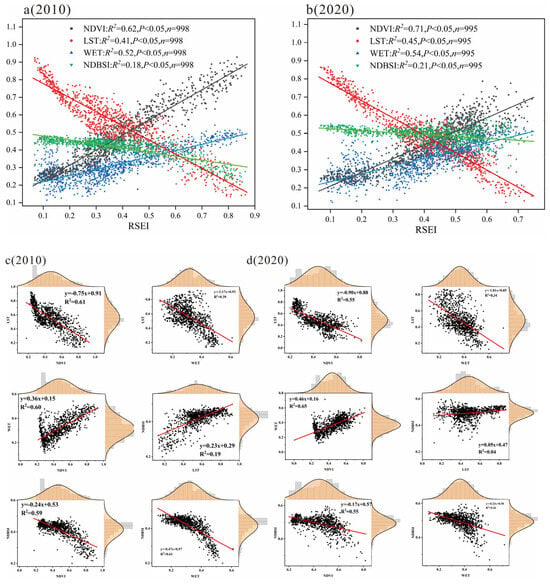
Figure 4.
Four-component scatter plot and histogram.
4.2. Analysis of Ecological Quality Based on RSEI
4.2.1. Interannual Variation Characteristics of Ecological Environment Quality in Inner Mongolia
As shown in Figure 5, the temporal analysis of the RSEI reveals several key findings regarding Inner Mongolia’s ecological evolution: the region exhibited a non-significant fluctuating upward trend in ecological quality (p > 0.05), with an annual change rate of 0.0024/a. The multi-year average RSEI of 0.41 indicates generally favorable ecological conditions throughout the study period. The minimum RSEI (0.34) occurred in 2007, potentially associated with specific climatic or anthropogenic stressors. The peak value (0.50) in 2020 suggests cumulative improvements in environmental management. This positive trajectory coincides with China’s increasingly stringent environmental regulations and systematic ecological restoration initiatives. The documented improvement provides empirical evidence for the effectiveness of implemented conservation policies and sustainable development strategies in arid and semi-arid ecosystems. The stable upward trend, though statistically non-significant at conventional levels (p > 0.05), demonstrates remarkable consistency given the region’s climatic variability. The 47% increase from minimum to maximum values underscores the potential for ecological recovery in fragile ecosystems under proper management.
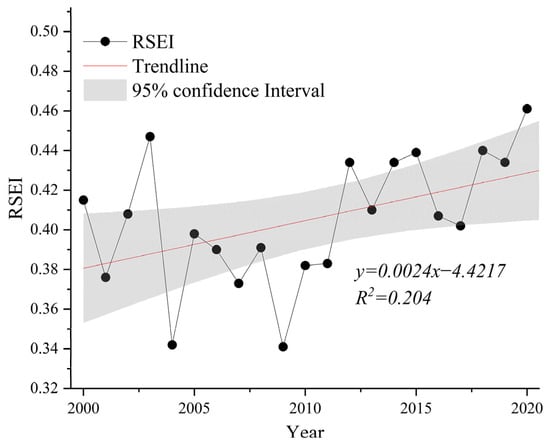
Figure 5.
Interannual variation trend of RSEI in the study area from 2000 to 2020.
Based on established ecological quality classification standards [14,28], this study categorized the Remote Sensing-based Ecological Index (RSEI) into five grading intervals: [0, 0.2) for poor, [0.2, 0.4) for fair, [0.4, 0.6) for moderate, [0.6, 0.8) for good, and [0.8, 1] for excellent quality. The spatiotemporal analysis of Inner Mongolia’s ecological quality from 2000 to 2020 revealed significant improvements (Table 4). Specifically, areas classified as poor and fair decreased by 269,582 km2 and 12,788 km2, respectively, while good and excellent quality areas increased by 71,073 km2 and 287,691 km2 correspondingly. Proportionally, the combined coverage of poor-to-moderate-grade areas declined from 87.59% to 55.91%, whereas good-to-excellent areas expanded from 12.4% to 44.1%. These marked changes demonstrate substantial overall ecological enhancement in Inner Mongolia over the past two decades, particularly evident in the northwestern grassland and forest regions, attributable to the implementation of various ecological conservation policies and management measures. The findings not only validate the effectiveness of regional environmental protection initiatives but also provide valuable references for future ecological restoration efforts.

Table 4.
Statistical results of ecological quality area and proportion in Inner Mongolia.
The statistical analysis of ecological quality transitions (Figure 6) reveals a three-phase improvement pattern in Inner Mongolia (2000–2020): (1) the initial widespread enhancement phase (2000–2005) saw most grades upgrading except Excellent; (2) the subsequent fluctuation phase (2005–2015) featured moderate Good-grade expansion (+3%) with stable other grades; and (3) the remarkable acceleration phase (2015–2020) witnessed dramatic “leapfrog” improvements—Good-grade areas surging from 15.75% to 37.41% and Excellent-grade expanding nearly sixfold (1.2%→6.96%). Notably, the total improved area consistently exceeded degraded areas across all periods, with the most significant transitions occurring in northwestern grasslands. These phased transitions quantitatively demonstrate the cumulative effects of ecological restoration, particularly highlighting the accelerated recovery during 2015–2020 under intensified conservation measures, ultimately confirming substantial net improvement in regional ecological quality.
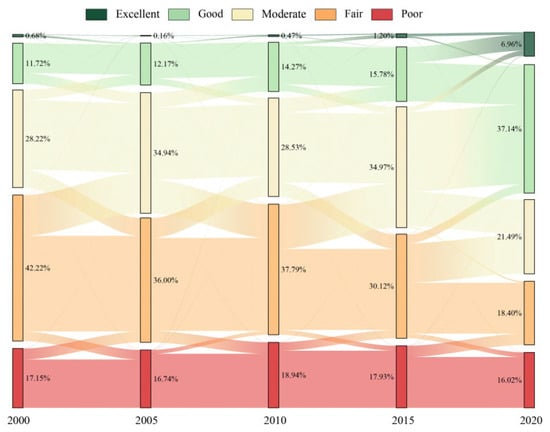
Figure 6.
Sankey diagram of ecological environment quality grade transfer matrix of Inner Mongolia.
4.2.2. Spatial Distribution Characteristics of Ecological Environment Quality in Inner Mongolia
The annual spatial distribution of ecological environment quality in Inner Mongolia from 2000 to 2020 is depicted in Figure 7. Influenced by topographical features and bioclimatic conditions, the ecological environment in Inner Mongolia exhibits distinct zonal distribution characteristics. The spatial distribution of ecological environment quality demonstrates a consistent pattern across the years, with “good” and “excellent” classifications predominantly located in the northeastern part of Inner Mongolia, while “poor” to “moderate” classifications are concentrated in the central and southwestern regions. Consequently, the ecological environment quality exhibits a gradual decline from the northeast to the southwest.
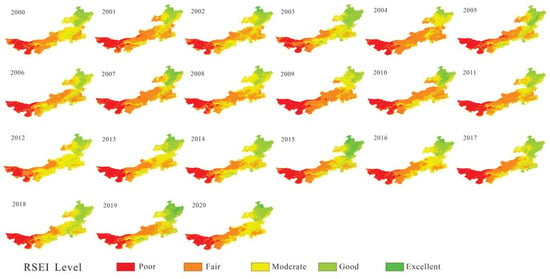
Figure 7.
Year-by-year spatial distribution of ecological environment quality.
Based on the average Remote Sensing Ecological Index (RSEI) for Inner Mongolia over the past 20 years (Figure 8) and following the aforementioned quality grading standards, we can draw the following conclusions: the spatial differences in the multi-year average ecological environment quality in Inner Mongolia are significant, exhibiting a certain degree of polarization, with a gradual decline from the northeast to the southwest.
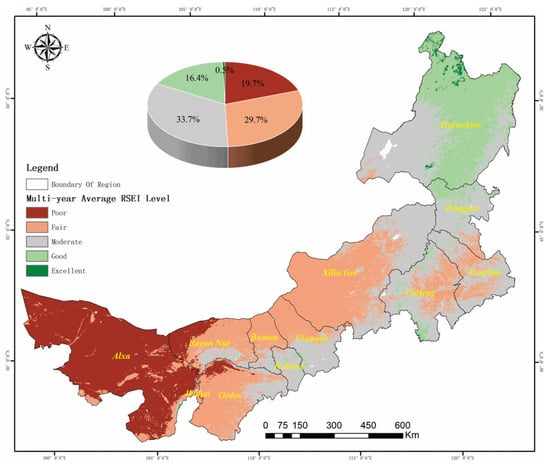
Figure 8.
Spatial distribution of multi-year average ecological environment quality.
Specifically, the area classified as “excellent” covers approximately 0.59 million km2, accounting for only 0.5% of the total area of Inner Mongolia, making it the smallest proportion among all ecological environment quality categories. This classification is primarily distributed in regions such as the northern edge of Hulunbuir in southeastern Inner Mongolia, characterized by higher vegetation coverage, diverse vegetation types, and relatively low human interference. These areas play an important role in climate stability, soil and water conservation, and the preservation of ecosystem security.
The area classified as “good” spans 19.4 million km2, comprising 16.4% of the total area, with a primary distribution across most of Hulunbuir, northern Hinggan, northern Tongliao, and the western edge of Chifeng. These regions are located within the Greater Khingan Range in China, exhibiting high vegetation coverage, effective water conservation capabilities, and substantial precipitation. The combined effects of vegetation and climate contribute to the relatively favorable ecological environment quality in these areas.
The “moderate” category occupies one-third of Inner Mongolia, reaching 33.70%, which translates to an area of approximately 39.87 million km2. This classification is found in regions including western Hohhot, Baotou, Ulanqab, northeastern Xilin Gol, and western Hulunbuir. The “fair” category encompasses 29.7% of the area, amounting to approximately 35.13 million km2, and exhibits a band-like spatial distribution primarily in Bayan Nur, northern Baotou, northern Ulanqab, and northern Xilin Gol, as well as in most regions of Wuhai and Ordos.
The area classified as “poor” constitutes 19.7%, covering approximately 23.31 million km2, distributed in northwestern Alxa, Bayan Nur, and the northern edge of Ordos. The regions with the worst ecological environment quality are situated along the edges of the Badain Jaran and Tengger Deserts, characterized by extensive expanses of desert and Gobi, such as the Badain Jaran Desert, Tengger Desert, and Ulan Buh Desert. These areas have extremely low vegetation coverage, are subject to severe wind and sand erosion, and experience a dry and arid climate with evaporation rates several times greater than precipitation, resulting in a harsh and fragile ecological environment.
To explore the trends in ecological environment quality across different regions of Inner Mongolia, we analyzed the annual average Remote Sensing Ecological Index (RSEI) for 12 administrative regions from 2000 to 2020 (Figure 8): Hinggan 0.53, Hohhot 0.48, Baotou 0.38, Xilin Gol 0.38, Wuhai 0.32, Chifeng 0.46, Tongliao 0.45, Ordos 0.34, Alxa 0.16, Hulunbuir 0.61, Bayan Nur 0.30, and Ulanqab 0.39. The overall average RSEI for Inner Mongolia is 0.41.
Among these regions (Figure 9), Hulunbuir has the best ecological quality, with an average RSEI of 0.61, while Alxa has the poorest ecological quality, with an average RSEI of only 0.16. The Greater Khingan Range runs through Hulunbuir in a northeast–southwest direction, forming an ecological pattern that includes the mountainous forest area of the eastern Greater Khingan Range, the Hulunbuir grassland in the west, and a transitional zone dominated by agricultural and pastoral enterprises. The overall ecological environment in these areas is relatively good. In contrast, Alxa is characterized by the presence of three major deserts: the Badain Jaran Desert, the Tengger Desert, and the Ulan Buh Desert, resulting in extremely low vegetation coverage and a poor ecological environment. The ecological environment quality in other regions remains at a relatively stable level of change.
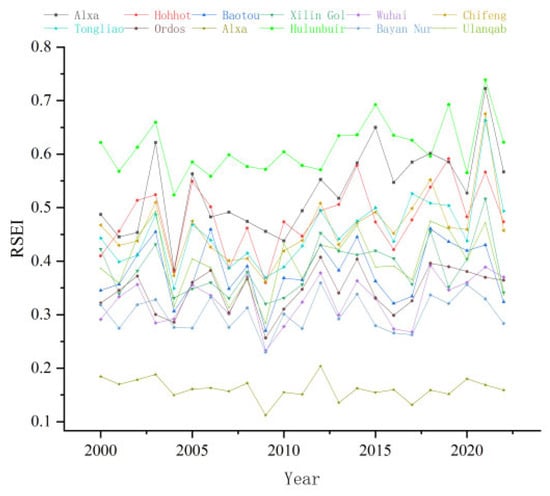
Figure 9.
Changes in RSEI across leagues and cities of Inner Mongolia (2000–2020).
Table 5 further presents the significance of RSEI trends across different regions of Inner Mongolia over the past two decades. The results demonstrate distinct regional patterns: Hinggan shows a Moderate Improvement trend, while Tongliao exhibits a Significant Improvement trend. In contrast, Alxa displays a Non-Significant Decrease. Most other regions demonstrate Non-Significant Improvement trends.

Table 5.
Changing trend and significance of RSEI in the study area from 2001 to 2020.
Collectively, these findings reveal that while Inner Mongolia as a whole shows a statistically significant increasing trend in RSEI, the spatial distribution and interannual variability of RSEI changes remain uneven across regions. The higher Sen’s slope values indicate substantial improvement magnitudes at the regional scale, yet this overall positive trend masks important geographical disparities in ecological quality changes. Notably, the significant improvements in Tongliao and moderate gains in Hinggan contrast with the non-significant changes (both positive and negative) observed in other areas, particularly the slight deterioration in Alxa. These spatial heterogeneities highlight the need for region-specific ecological management strategies to address varying environmental challenges across Inner Mongolia’s diverse landscapes.
4.3. Analysis of Temporal Dynamic Features of Ecological Quality
From Figure 10 and Table 6, it can be observed that the regions where ecological environmental quality shows an improving trend account for 75.81% of the total area, with 14.99% of these areas exhibiting significant and extremely significant improvement. Areas that remain relatively stable constitute only 0.43%, while regions experiencing degradation make up 23.75%, with those showing significant and extremely significant degradation accounting for 0.45%. Areas of habitat quality improvement are primarily distributed in the western part of Hulunbuir City, Hinggan League, Tongliao City, and Chifeng City, while significant and extremely significant degradation areas are sporadically found in Alxa League and central Hulunbuir City. In summary, while the habitat quality in some areas of Inner Mongolia has shown improvement and the enhancement of ecological environment quality predominates, there remains a problem of ecological environmental degradation.
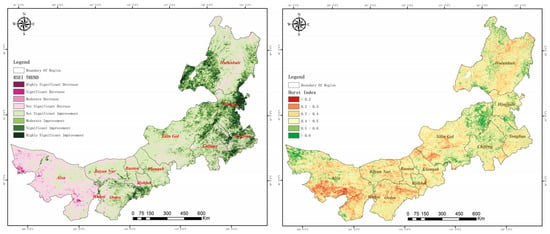
Figure 10.
Analysis of the dynamic change trend of RSEI from 2000 to 2020 (RSEI trend, Hurst index).

Table 6.
Changing trend and significance of RSEI in the study area from 2001 to 2020.
To further study the future trend of habitat quality in Inner Mongolia, an analysis of the spatial distribution of the Hurst index of RSEI reveals that in the future Figure 10, approximately 56.04% of the areas will experience changes in ecological environmental quality trends that are generally opposite to those of the past 20 years. These areas are mainly located in the vast regions west of the Greater Khingan Mountains. Additionally, 43.96% of the ecological environmental quality is expected to continue improving, primarily distributed around Hulunbuir City, Hinggan League, Tongliao City, and Chifeng City, with some sporadic occurrences in the central and western regions.
4.4. Analysis of Natural Factors Influencing RSEI in Inner Mongolia
The driving factors of ecological environment quality in the study area were analyzed using the geographical detector method. Selecting 2010 and 2020 as the time points for factor detection, with the RSEI as the dependent variable, we chose 11 representative influencing factors from surface factors, climatic factors, and anthropogenic factors as independent variables to assess their explanatory power and dominant factors on habitat quality in Inner Mongolia. For the geographical detector analysis, all input factors were discretized using the natural breaks method (Jenks) with five classification intervals. Socioeconomic data were resampled to 1 km grid resolution using an area-weighted approach to maintain population/GDP density conservation. After discretizing the influencing factors, geographical detection was performed. The various influencing factors are shown in Table 7.

Table 7.
Impact factors on ecological environment quality in Inner Mongolia.
4.4.1. Single-Factor Detection Results
As shown in Figure 11, The single-factor Geodetector results demonstrated that all driving factors except nighttime light intensity significantly influenced the spatial distribution of RSEI in Inner Mongolia (p < 0.05), with the NDVI emerging as the dominant driver (q = 0.847 in 2010 and 0.915 in 2020), followed by the climatic factors PRE and TEM (q > 0.68). The consistent q-value ranking across 2010 and 2020 (NDVI > PRE > TEM > LO > LA > SL > AL > GDP > POP > AS > NIT) revealed stable explanatory patterns, where geographical and climatic factors collectively explained over 75% of spatial heterogeneity, while anthropogenic factors (GDP, POP, NIT) showed limited influence (q < 0.35, <15% contribution). These findings fundamentally indicate that natural environmental changes—particularly vegetation dynamics driven by successful ecological restoration programs like Grain-for-Green—predominated over human activities in shaping Inner Mongolia’s ecological patterns during 2000–2020, with the NDVI serving as the primary indicator of ecological improvement.
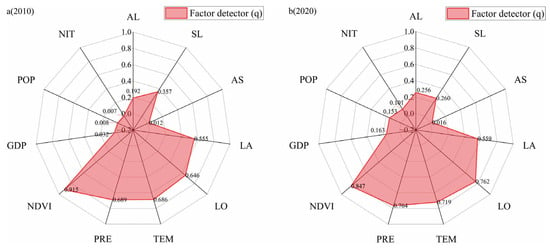
Figure 11.
Single-factor detection results.
4.4.2. Interaction Detection Results
The interaction detection results (Figure 12) demonstrate that the explanatory power of all factors on the RSEI was significantly enhanced through interactive effects, with no independent or weakening relationships observed, indicating Inner Mongolia’s habitat quality changes resulted from complex interactions among geographical, climatic, and anthropogenic factors. Analysis revealed two primary interaction types: bi-factor enhancement (40%) and nonlinear enhancement (60%). Notably, while the dominant individual factors (NDVI, PRE, TEM) maintained strong interactive effects, unexpected synergies emerged—GDP × PRE (2010) surpassed higher-ranked NS × PRE, and NDVI × GDP (2020) outperformed all other combinations, exhibiting 72% q-value enhancement. These findings fundamentally expand our understanding beyond single-factor analysis: (1) although natural factors remain primary drivers, they operate through complex interaction networks that increase explanatory power by 35–50%; (2) anthropogenic factors demonstrate substantially greater influence through synergistic effects than individual impacts alone; and (3) interaction effects explain an additional 22% of spatial variance unaccounted for by single-factor models. This highlights the necessity of adopting an integrated management framework that incorporates these nonlinear synergies, particularly the amplified role of human activities when interacting with climatic variables, to better understand the spatial heterogeneity of ecological restoration outcomes across Inner Mongolia’s diverse ecoregions.
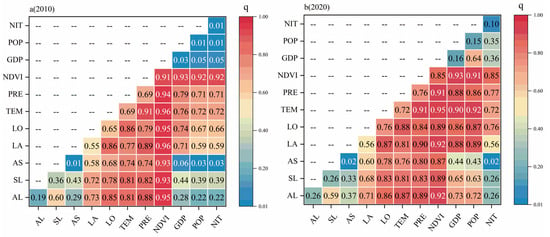
Figure 12.
Factor interaction detection results for 2010 and 2020.
5. Discussion
- Future research directions based on this study:
In constructing the RSEI index, water bodies were masked to avoid interference with indicators [32,33], consequently excluding aquatic environmental quality from assessment. However, as critical components of ecosystems, water bodies significantly impact ecological environments [34]. Existing studies have demonstrated remote sensing-based monitoring of water [35,36,37,38] and atmospheric parameters [39,40,41]. Future research will incorporate water- and atmosphere-related indices to establish a comprehensive watershed eco-environmental quality evaluation system, enabling holistic assessment of ecological changes in Inner Mongolia.
As a vital ecological barrier in northern China, the Mongolian Plateau’s changes (e.g., desertification, grassland degradation, dust storms) profoundly affect regional ecological security. While progress has been made in RSEI-based studies [42,43,44], future work should focus on integrating multi-source data (e.g., CMlP6 precipitation/temperature projections [45,46]) and incorporating human activity data (NPP-VllRS nighttime lights, mining area interpretation) [47,48,49] to enhance cross-border ecological monitoring and governance capabilities.
- 2.
- Potential practical applications:
The MODlS products used in this study have been academically validated and show reliable accuracy in Inner Mongolia [50,51]. The remote sensing-based habitat quality assessment method offers advantages through diversified data sources and minimal subjective bias, overcoming challenges in obtaining long-term, large-scale regional data. This approach not only provides insights for improving habitat quality in Inner Mongolia but can also be extended to RSEI studies in other regions.
6. Conclusions
This study utilized the Google Earth Engine platform and continuous spatiotemporal MODIS remote sensing data and products to investigate the spatiotemporal evolution of ecological environment quality in Inner Mongolia from 2000 to 2020. Furthermore, the study examined the natural and anthropogenic factors influencing spatial differentiation in the changes in ecological environment quality in Inner Mongolia. The key findings are as follows:
- The correlation between the RSEI and the NDVI, LST, NDBSI, and WET ecological indices is higher than the correlation between individual ecological indices, indicating that the RSEI can better comprehensively reflect the ecological environment quality in Inner Mongolia. Among these, changes in the NDVI have the greatest impact on the ecological environment quality in Inner Mongolia, while changes in the NDBSI have the smallest impact.
- From 2000 to 2020, the average RSEI in Inner Mongolia showed an overall upward trend with fluctuations, which has been confirmed as statistically significant at a 95% confidence level. By analyzing the spatial transition matrix, it was found that different ecological positions have shifted over the 20-year period. The major area transitions occurred between adjacent two levels, with the area of improvement greater than the area of deterioration, indicating an overall improvement in ecological quality.
- In terms of interannual variations, the ecological environment quality in Inner Mongolia showed a non-significant fluctuating upward trend from 2000 to 2020. The areas classified as excellent, good, moderate, relatively poor, and poor, respectively, showed trends of non-significant increase, significant increase, non-significant decrease, and non-significant increase. In terms of spatial distribution, there is a polarization in the ecological environment quality, gradually deteriorating from northeast to southwest.
- The RSEI demonstrated stronger correlations with individual ecological indicators (NDVI, LST, NDBSI, WET) than between the indicators themselves, confirming its superior comprehensive representation of ecological quality. Among these, NDVI changes exerted the greatest influence on ecological quality, while NDBSI showed the least impact.
- From 2000 to 2020, the average RSEI in Inner Mongolia showed a significant upward trend with fluctuations (p < 0.05). Spatial transition matrix analysis indicated that changes in ecological quality primarily occurred between adjacent grades, with the area of improvement significantly exceeding that of degradation. Despite periodic fluctuations, the overall ecological quality demonstrated progressive enhancement, suggesting effective implementation of ecological restoration measures across the region.
- Interannual variation analysis revealed a non-significant but consistent improving trend in overall ecological quality. Notably, areas classified as “Good” experienced significant expansion, while spatial distribution patterns exhibited clear polarization—displaying a distinct northeast-to-southwest degradation gradient. This spatial heterogeneity reflects the varying effectiveness of conservation measures across different ecological zones.
- Future projections suggest divergent trends: over 50% of regions (predominantly located west of the Greater Khingan Range) may undergo trend reversals, potentially due to climate change impacts and human pressure. Conversely, other areas are projected to maintain their current improvement trajectories, particularly where ecological protection policies have been consistently implemented. Driving factor analysis demonstrated the predominant influence of natural factors (NDVI, precipitation and temperature) on ecological changes. However, human activities exhibited amplified effects through interactive processes (e.g., GDP × precipitation synergy). Remarkably, these interaction effects accounted for an additional 22% of spatial variance beyond what single factors could explain, highlighting the complex nature of ecological quality dynamics in arid and semi-arid environments.
Author Contributions
G.J. and T.L. designed the research and prepared the manuscript. The data were prepared by G.J., Z.L. and K.L. Y.F. and Z.H. helped revise the manuscript. The manuscript was checked by G.J. and Y.F. All authors have read and agreed to the published version of the manuscript.
Funding
This research was funded by the Yinshanbeilu Grassland Eco-hydrology National Observation and Research Station, China Institute of Water Resources and Hydropower Research (MK2022J16) (YSS202317), Inner Mongolia Science and Technology Plan Project (MK0143A012022), China Institute of Water Resources and Hydropower Research (MK2021J09, MK2023J08), and the Collaborative InnovalionCenler for Grassland Ecological Security (Jointly Supported by the Ministry of Education of China and InnerMongolia Autonomous Region), Hohhot010021.China.
Institutional Review Board Statement
Not applicable.
Informed Consent Statement
Not applicable.
Data Availability Statement
The data presented in this study are available on request from the corresponding author.
Conflicts of Interest
The authors declare no conflicts of interest.
References
- Xu, H.Q. A remote sensing urban ecological index and its application. Acta Ecol. Sin. 2013, 33, 7853–7862. [Google Scholar]
- Xu, H.; Wang, Y.; Guan, H.; Shi, T.; Hu, X. Detecting ecological changes with a remote sensing based ecological index (RSEl) produced time series and change vector analysis. Remote Sens. 2019, 11, 2345. [Google Scholar] [CrossRef]
- Wu, Y.J.; Zhao, X.; Xi, Y.; Liu, H.; Li, C. Comprehensive evaluation and spatial-temporal changes of eco-environmental quality based on MODIS in Tibet during 2006–2016. Acta Geogr. Sin. 2019, 74, 1438–1449. [Google Scholar]
- Ye, B.W.; Sun, B.; Shi, X.H.; Zhao, Y.L.; Pang, J.Q.; Guo, Y.Y.; Yao, W.Z. Land use changes and its impact on ecological environment quality in Bayannur City. Environ. Sci. 2024, 45, 6899–6909. [Google Scholar]
- Yang, P.; Zhou, A.N.; Fu, K.X.; Wang, Y.K.; Luo, H. Assessment and analysis on roadside ecological environment quality along typical sections of Qinghai-Tibet Highway based on remote sensing ecological indices. J. Arid. Land Resour. Environ. 2024, 38, 39–48. [Google Scholar]
- Zhang, H.B.; Wang, W.; Song, Y.J.; Miao, L.G.; Ma, C. Ecological index evaluation of arid inflow area based on the modified remote sensing ecological index: A case study of Tabu River Basin at the northern foot of the Yin Mountains. Acta Ecol. Sin. 2024, 44, 523–543. [Google Scholar]
- Wen, Y.H. Assessment and spatial-temporal evolution environment in Gansu Province from 2011 to 2021. J. Arid. Land Resour. Environ. 2024, 38, 110–119. [Google Scholar]
- Li, X.; Yu, K.X.; Xu, G.C.; Li, P.; Li, Z.B.; Shi, P. Spatial characteristics and driving factors of net primary productivity of vegetation in the upper and middle Yellow River Basin. Environ. Sci. 2024, 45, 6448–6457. [Google Scholar] [CrossRef]
- Li, P.; Wang, J.; Liu, M.; Xue, Z.; Bagherzadeh, A.; Liu, M. Spatio-temporal variation characteristics of NDVI and its response to climate on the Loess Plateau from 1985 to 2015. Catena 2021, 203, 105331. [Google Scholar] [CrossRef]
- Gao, W.; Zheng, C.; Liu, X.; Lu, Y.; Chen, Y.; Wei, Y.; Ma, Y. NDVI-based vegetation dynamics and their reponses to climate change and human activities from 1982 to 2020: A case study in the Mu Us Sandy Land, China. Ecol. Indic. 2022, 137, 108745. [Google Scholar] [CrossRef]
- Mu, X.; Guo, X.; Ming, Q.; Hu, C. Dynamic evolution characteristics and driving factors of tourism ecological security in the Yellow River Basin. Acta Geogr. Sin. 2022, 77, 714–735. [Google Scholar]
- Wang, M.Y.; Wang, L.C.; Mo, L.; Mo, L.; Mu, X.D.; Ma, Z.W.; Wang, S.; Chen, X.L.; Liu, C.; Wang, L.; et al. Theoretical research and practice of water ecological assessment in tropical island watershed: A case study in Hainan Province. China Environ. Sci. 2024, 44, 3334–3341. [Google Scholar]
- Carlson, T.N.; Ripley, D.A. On the relation between NDVl, fractional vegetation cover, and leaf area index. Remote Sens. Environ. 1997, 62, 241–252. [Google Scholar] [CrossRef]
- Li, Y.; Li, Y.; Yang, X.; Feng, X.; Lv, S. Evaluation and driving force analysis of ecological quality in Central yunnan urban Agglomeration. Ecol. Indic. 2024, 158, 111598. [Google Scholar] [CrossRef]
- Qlao, M.; Zhang, Y.; Yu, L. Dynamic Monitoring of Ecological Environment Quality in Beijing Based on Remote Sensing Ecological Index. J. N. China Univ. Sci. Technol. Nat. Sci. Ed. 2020, 42, 17–23. [Google Scholar]
- Li, H.X.; Huang, J.J.; Liang, Y.J. Evaluating the quality of ecological environment in Wuhan based on remote sensing ecological index. J. Yunnan Univ. Nat. Sci. Ed. 2020, 42, 81–90. [Google Scholar]
- Feng, L.; Jia, Z.; Li, Q.; Zhao, A.; Zhao, Y.; Zhang, Z. Spatiotemporal change of sparse vegetation coverage in Northern China. J. Indian Soc. Remote Sens. 2019, 47, 359–366. [Google Scholar] [CrossRef]
- Chen, C.; Fu, J.; Zhang, S.; Zhao, X. Coastline information extraction based on the tasseled cap transformation of Landsat-8 0LI images. Estuar. Coast. Shelf Sci. 2019, 217, 281–291. [Google Scholar] [CrossRef]
- Wang, W.; Wang, X.L.; Feng, Z.K.; Dong, S. Dynamic evaluation of eco-environmental quality in the capital economic circle based on RS and GIS. J. Anhui Agric. Univ. 2015, 42, 257–262. [Google Scholar]
- Yuan, L.; Jiang, W.; Shen, W.; Liu, Y. The spatiotemporal variations of vegetation cover in the Yellow River Basin from 2000 to 2010. Acta Ecol. Sin. 2013, 33, 7798–7806. [Google Scholar]
- Gao, Z.X.; Bao, A.M.; Zheng, G.X.; Huang, X. Grassland degradation assessment based on spatial heterogeneity in Kwlusitai. J. Univ. Chin. Acad. Sci. 2023, 40, 735–742. [Google Scholar]
- Tian, Z.H.; Ren, Z.G.; Wei, H.T. Driving mechanism of the spatiotemporal evolution of vegetation in the Yellow River Basin from 2000 to 2020. Environ. Sci. 2022, 43, 743–751. [Google Scholar]
- Wu, S.; Gao, X.; Lei, J.; Zhou, N.; Guo, Z.; Shang, B. Ecological environment quality evaluation of the Sahel region in Africa based on remote sensing ecological index. J. Arid. Land 2022, 14, 14–33. [Google Scholar] [CrossRef]
- Chen, L.W. Spatiotemporal variation of water use efficiency and its responses to environ mental factors in Yellow River Basin during 2001–2020. Bull. Soil Water Conserv. 2022, 42, 222–230. [Google Scholar]
- Wang, Y.; Xu, Y.; Yang, J.; Chen, Y.; Wei, J.; Zhou, J.; Zhang, W.; Cheng, W. Dynamic monitoring and spatio-temporal pattern evolution analysis of eco-environmental quality in Chongqing based on remote sensing. Acta Ecol. Sin. 2023, 43, 6278–6292. [Google Scholar]
- Wang, J.; Xu, C. Geodetector: Principle and prospective. ACTA Geogr. Sin. 2017, 43, 116–134. [Google Scholar] [CrossRef]
- Hu, Y.; Luo, H.; Dai, S.; Deng, C.; Li, H.; Liang, W.; Zheng, Q. Evaluation of ecological environment quality and analysis of driving mechanism in Wuzhishan City of Hainan Island based on remote sensing ecological indices. Ecol. Environ. Sci. 2024, 33, 1624–1633. [Google Scholar]
- Fu, S.T.; He, C.X.; Ma, J.K.; Wang, B.; Zhen, Z.L. Ecological environment quality of the Shanxi section of the Yellow River Basin under different development scenarios. Chin. J. Appl. Ecol. 2024, 35, 1337–1346. [Google Scholar]
- Zhou, X.; Guo, H.; Deng, Z.; Liang, B. Change of remote sensing ecological index of an oasis city in the arid area. Resour. Sci. 2019, 41, 1002–1012. [Google Scholar]
- Zhang, A.-S. Dynamic Monitoring and Analysis of Ecological Environment in Wuhai City based on the RSEI Model. J. Heilongjiang Inst. Ecol. Eng. 2019, 32, 1–5. [Google Scholar]
- Yao, C.; Zhao, H.; Ren, Y. Assessment of Urban Ecological Environment Quality Change in Taiyuan City Based on Remote Sensing Ecological Index. Meteorol. Environ. Sci. 2024, 47, 85–89. [Google Scholar]
- Xu, H.Q.; Ding, F.; Wen, X. Urban expansion and heat island dynamics in the Quanzhou region, China. IEEE J. Sel. Top. Appl. Earth Obs. Remote Sens. 2009, 2, 74–79. [Google Scholar] [CrossRef]
- Xu, D.; Yang, F.; Yu, L.; Zhou, Y.; Li, H.; Ma, J.; Huang, J.; Wei, J.; Xu, Y.; Zhang, C.; et al. Quantization of the coupling mechanism between eco-environmental quality and urbanization from multisource remote sensing data. J. Clean. Prod. 2021, 321, 128948. [Google Scholar] [CrossRef]
- Yu, H.J.; Zhang, F.M.; Ma, H.; Lu, Y.Y. Quality in the Huai River Basin baed on RSEl spatio-temporal evolution and driving factors of ecological environment. Environ. Sci. 2024, 45, 4112–4121. [Google Scholar]
- Fu, L.; Zhou, Y.; Liu, G.; Song, K.; Tao, H.; Zhao, F.; Li, S.; Shi, S.; Shang, Y. Retrieval of Chla concentrations in Lake Xingkai using OLCl images. Remote Sens. 2023, 15, 3809. [Google Scholar] [CrossRef]
- Jayaram, C.; Patidar, G.; Swain, D.; Chowdary, V.M.; Bandyopadhyay, S. Total suspended matter distribution in the hooghly river estuary and the sundarbans: A remote sensing approach. IEEE J. Sel. Top. Appl. Earth Obs. Remote Sens. 2021, 14, 9064–9070. [Google Scholar] [CrossRef]
- Lu, S.; Deng, R.; Liang, Y.; Xiong, L.; Ai, X.; Qin, Y. Remote sensing retrieval of total phosphorus in the pearl river chanels based on the GF-l remote sensing data. Remote Sens. 2020, 12, 1420. [Google Scholar] [CrossRef]
- Wang, S.M.; Qin, B.Q. Research progress on remote sensing monitoring of lake water quality parameters. Environ. Sci. 2023, 44, 1228–1243. [Google Scholar]
- Wei, J.; Li, Z.; Lyapustin, A.; Sun, L.; Peng, Y.; Xue, W.; Su, T.; Cribb, M. Reconstructing 1-km-resolution high-quality PM2.5 data records from 2000 to 2018 in China: Spatiotemporal variations and policy implications. Remote Sens. Environ. 2021, 252, 112136. [Google Scholar] [CrossRef]
- Dai, Y.Y.; Gong, S.Q.; Zhang, C.J.; Min, A.L.; Wang, H.J. Remote sensing model for estimating atmospheric PM, concentration in the Guanedong-Hong Kone-Macao Greater Bay Area. Environ. Sci. 2024, 45, 8–22. [Google Scholar]
- Li, S.X.; Zou, B.; Zhang, F.Y.; Liu, N.; Xue, C.H.; Liu, J. Regionalization and analysis of PM2.5 and O3 synergetic prevention and control areas based on remote sensing data. Environ. Sci. 2022, 43, 4293–4304. [Google Scholar]
- Crist, E.P.; Cicone, R.C. A physically-based transformation of the Matic mapper data—The TM tasseled cap. IEEE Trans. Geosci. Remote Sens. 1984, 3, 256–263. [Google Scholar] [CrossRef]
- Derdouri, A.; Murayama, Y.; Morimoto, T. Spatiotemporal thermal variations in Moroccan cities: A comparative analysis. Sensors 2023, 23, 6229. [Google Scholar] [CrossRef] [PubMed]
- Gan, X.; Wilson, M.; Zhao, Y.; Wu, J.; Fernandez, I.C.; Guo, J.; Zhou, B. When to use what: Methods for weighting and aggregating sustainability indicators. Ecol. Indic. 2017, 81, 491–502. [Google Scholar] [CrossRef]
- Gong, C.; Lyu, F.; Wang, Y. Spatiotemporal change and drivers of ecosystem quality in the Loess Plateau based on RSEI: A case study of Shanxi, China. Ecol. Indic. 2023, 155, 111060. [Google Scholar] [CrossRef]
- Huang, C.; Wylie, B.; Yang, L.; Homer, C.; Zylstra, G. Derivation of atasselled cap transformation based on Landsat 7 at-satellite reflectance. Int. J. Remote Sens. 2002, 23, 1741–1748. [Google Scholar] [CrossRef]
- Xu, H.Q. A new index for delineating built-up land features insatellite imagery. Int. J. Remote Sens. 2008, 29, 4269–4276. [Google Scholar] [CrossRef]
- Li, X.; Xu, H.Q.; Li, J.; Guo, Y. Extraction of bare soil features from SPOT-5 imagery based on NDSI and NDISI. J. Geo Inf. Sci. 2016, 18, 117–123. [Google Scholar]
- Xu, Z.; Dai, Y.; Liu, W. Does environmental audit help to improve water quality Evidence from the China National Environmental Monitoring Centre. Sci. Total Environ. 2022, 823, 153485. [Google Scholar] [CrossRef]
- Yang, H.; Yu, J.; Xu, W.; Wu, Y.; Lei, X.; Ye, J.; Geng, J.; Ding, Z. Long-time series ecological environment quality monitoring and cause analysis in the Dianchi Lake Basin, China. Ecol. Indic. 2023, 148, 110084. [Google Scholar] [CrossRef]
- Yan, Z.Y.; Zhang, S.W.; Wang, Y.X. Spatiotemporal dynamics of fractional vegetation cover and climate response in Inner Mongolia during 1982–2021 based on GEE. Trans. Chin. Soc. Agric. Eng. 2023, 39, 94–102. [Google Scholar]
Disclaimer/Publisher’s Note: The statements, opinions and data contained in all publications are solely those of the individual author(s) and contributor(s) and not of MDPI and/or the editor(s). MDPI and/or the editor(s) disclaim responsibility for any injury to people or property resulting from any ideas, methods, instructions or products referred to in the content. |
© 2025 by the authors. Licensee MDPI, Basel, Switzerland. This article is an open access article distributed under the terms and conditions of the Creative Commons Attribution (CC BY) license (https://creativecommons.org/licenses/by/4.0/).